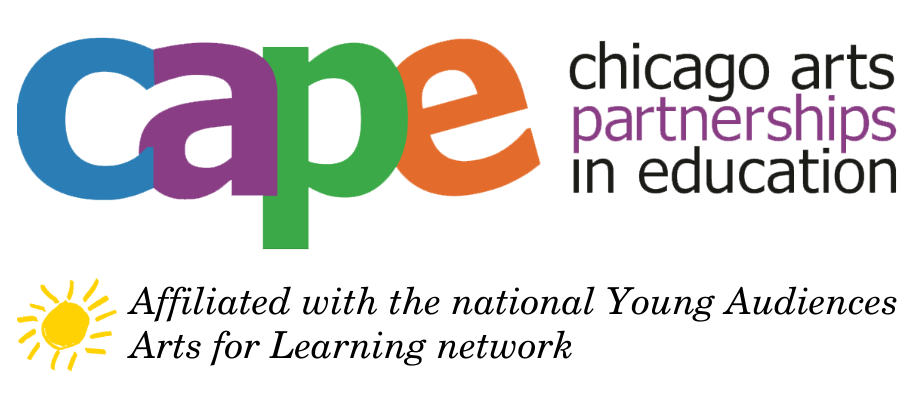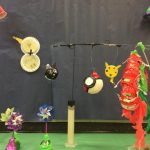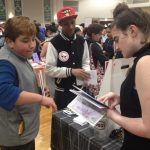Curriculum Example: Henry Elementary 2018
We worked with Henry Elementary during the 2016-2017 school year to integrate visual art and engineering. Below is a description of their project, as it was documented in their classroom portfolio.
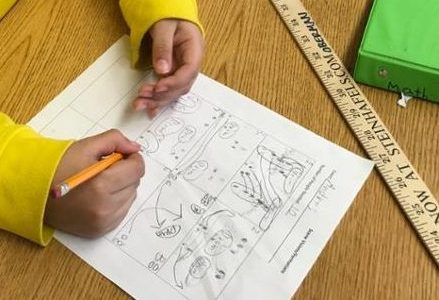
- Project Title: We Are History Makers
- School: Henry Elementary
- Teacher(s): Dani Oberman
- Artist(s): Ayako Kato
- Grade(s): 3
- Academic focus: Social Science + History
- Artistic focus: Dance
The Big Idea: We Are History Makers
Inquiry Question: What is our responsibility as citizens of Chicago to know about events that have previously taken place?
Project Narrative:
The students got to pick an event in Chicago’s history to research and create a newspaper article for. Based on these events, Ayako grouped them into categories with music after the students brainstormed how they envisioned the movements working for that particular event. Using the students’ choreographed ideas, Ayako and I worked with the students to make sure that their vision was portrayed. The final project was a choreographed dance and interpretation of Chicago’s history.
Our hope was that our students would:
- Recognize deeper reason why they are socially “here” now.
- Start to see relationships between themselves and parents, peers, school, community and Chicago in relation to Chicago History.
- Perceive history as not something plastic, but something alive and, from there, create movement.
- Recognize that they are a part of a current history taking place and they are paving the way for future generations.
Project Outcomes:
-
Dani: I was shocked at how abstractly and creatively the students thought about the deliberate movements they chose to represent the events in Chicago’s history despite the lack of creative time given to them in school (we do not have a Music class and Art class is only one hour each week). They were able to connect history that had taken place years before their existence with the impact it had on their lives today.
-
Ayako: Students of Henry at 105 surprised me with their level of focus, interests, and determination to create this dance work on history. Normally, students take so much time to develop and learn movement phrase and remember the sequence, entrance, and exit during the piece. Yet they ended up creating this epic 20 minute Chicago History “We are History” dance in 15 hours.
This project was successful in many ways:
- Dance motivated students to research and learn history
- Allowed students to improvise, build, and solidify the dance work through rehearsals over time
- Exercised through dance
- Generated responsibility and empathy by having every student be both choreographers and dancers
- Early music selection and let students move with it
- Classroom teacher’s extra time and effort to rehearse with students
- Long teaching artist visits- 90 minutes each!
Academic+Art Standards Addressed:
Literacy:
CCSS.ELA-LITERACY.RI.3.3
Describe the relationship between a series of historical events, scientific ideas or concepts, or steps in technical procedures in a text, using language that pertains to time, sequence, and cause/effect.
CCSS.ELA-LITERACY.RI.3.4
Determine the meaning of general academic and domain-specific words and phrases in a text relevant to a grade 3 topic or subject area.
CCSS.ELA-LITERACY.RI.3.5
Use text features and search tools (e.g., key words, sidebars, hyperlinks) to locate information relevant to a given topic efficiently.
CCSS.ELA-LITERACY.RI.3.7
Use information gained from illustrations (e.g., maps, photographs) and the words in a text to demonstrate understanding of the text (e.g., where, when, why, and how key events occur).
CCSS.ELA-LITERACY.SL.3.1
Engage effectively in a range of collaborative discussions (one-on-one, in groups, and teacher-led) with diverse partners on grade 3 topics and texts, building on others’ ideas and expressing their own clearly.
Core Arts Standards: Dance, Grade 3
DA:Cr1.1.3
a. Experiment with a variety of self-identified stimuli (for example, music/sound, text, objects, images, notation, observed dance, experiences) for movement.
b. Explore a given movement problem. Select and demonstrate a solution.
DA:Cr2.1.3
a.Identify and experiment with choreographic devices to create simple movement patterns and dance structures (for example, AB, ABA, theme and development).
b.Develop a dance phrase that expresses and communicates an idea or feeling. Discuss the effect of the movement choices.
DA:Cr3.1.3
a.Revise movement choices in response to feedback to improve a short dance study. Describe the differences the changes made in the movements.
b. Depict directions or spatial pathways in a dance phrase by drawing a picture map or using a symbol.
DA:Pr4.1.3
a. Judge spaces as distance traveled and use space three-dimensionally. Demonstrate shapes with positive and negative space. Perform movement sequences in and through space with intentionality and focus.
b. Fulfill specified duration of time with improvised locomotor and non-locomotor movements. Differentiate between “in time” and “out of time” to music. Perform movements that are the same or of a different time orientation to accompaniment. Use metric and kinesthetic phrasing.
c. Change use of energy and dynamics by modifying movements and applying specific characteristics to heighten the effect of their intent.
DA:Pr5.1.3
a. Replicate body shapes, movement characteristics, and movement patterns in a dance sequence with awareness of body alignment and core support.
b. Adjust body-use to coordinate with a partner or other dancers to safely change levels, directions, and pathway designs.
c. Recall movement sequences with a partner or in group dance activities. Apply constructive feedback from teacher and self-check to improve dance skills.
DA:Pr6.1.3
a. Identify the main areas of a performance space using production terminology (for example, stage right, stage left, center stage, upstage, and downstage).
b. Explore simple production elements (costumes, props, music, scenery, lighting, or media) for a dance performed for an audience in a designated specific performance space.
We worked with Goudy Elementary during the 2016-2017 school year to integrate visual art and engineering. Below is a description of their project, as it was documented in their classroom portfolio.
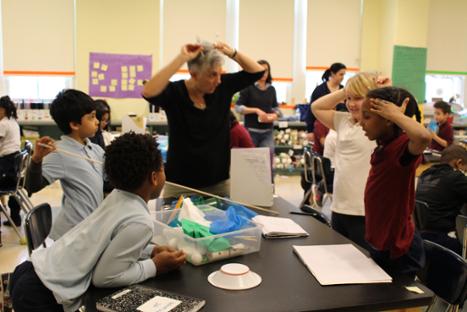 Project Title: Air, Land, Water, Sculpture
Project Title: Air, Land, Water, Sculpture- School: Goudy Elementary
- Teacher(s): Patty Whitehouse
- Artist(s): Margy Stover
- Grade(s): 2
- Academic focus: Engineering
- Artistic focus: Kinetic sculpture
The Big Idea: Integrating engineering with art to explore how sculpture can interact with forces, such as air, in the same ways that windmills and turbines do.
Inquiry Question: How can you create a sculpture based on the interaction forces and materials?
Project Narrative:
Patty is the Engineering Lab teacher for K-6 students at Goudy, focusing on the engineering part of Goudy’s science curriculum that is aligned with the Next Generation Science Standards (NGSS). Students in 2nd grade are working with wind forces as part of their weather unit. They create windmills that must fit a particular set of constraints and criteria as described earlier in this project. Once that project is completed, students use what they’ve learned about wind, windmills, materials and engineering design process to create mobile sculptures that move in the wind. Each class used a different theme for their mobiles. One class made mobiles that moved as if they were in water when they were blown around by the fan. A second class created mobiles that represented things that moved on land, and the third class created mobiles that represented things that moved in the air–and space.
Students used a basic form of the Engineering Design Process to support their plans. The process includes:
Asking Questions about the project to learn about the constraints and criteria for the project: — –What kinds of things move in the water/land/air?
-Which materials are available? How can I represent things I need with the materials available for use?
-What does the sculpture need to do? Which parts will move? How do the materials interact? How will I hold up my mobile?
Imagining a Solution to the engineering problem at hand. This is the brainstorming portion of the project. Students sketch their ideas in a journal, share them with their team, and make a decision about which ideas they want to work on.
Making a Plan from the imagined solutions. A plan shows the design, the type, size and quantity of materials needed.
Creating the Sculpture using the plan. This is place where students may find out that the plan needs refining because the sculpture does not work as planned.
Revising/Improving the Sculpture until the constraints and criteria are met to a satisfactory degree. This part of the process may take several iterations, and may send the students back to any prior portion of the process.

Project Outcomes:
- In the past, we worked with 3rd and 4th graders, who seemed to have a better connection between what they could do and what they wanted to do. Second graders are still working on that concept, and they had a more difficult time with their mobiles not looking like they originally wanted them to. What is always surprising is the creativity of students of any age when they are given the opportunity to make use of their imaginations. The end products were amazing!
- Students were their own critics and masters of their mobile design. In the end, they were able to create a series of mobiles that met the criteria and constraints with a great deal more imagination than we originally anticipated. Building and designing require less common language, so students with less command of English were able to flourish as designers and builders. Students and teachers in Kindergarten-3rd grade were given a “tour” of the mobile-scape. Other students, teachers, and visitors were able to see the sculptures for two weeks when it was set up in the hall. Sharing this project accomplished a couple of things: The three second grade classes were interested in seeing what the other classes were doing in relation to their theme. They all used the same materials but did so many different things with them! We were able to talk about interpreting and critique–in 2nd grade terms, of course–so they were able to enjoy and comment on others’ work without feeling like they had to compare it to their own. And now four other teachers to want to participate in CAPE next year!
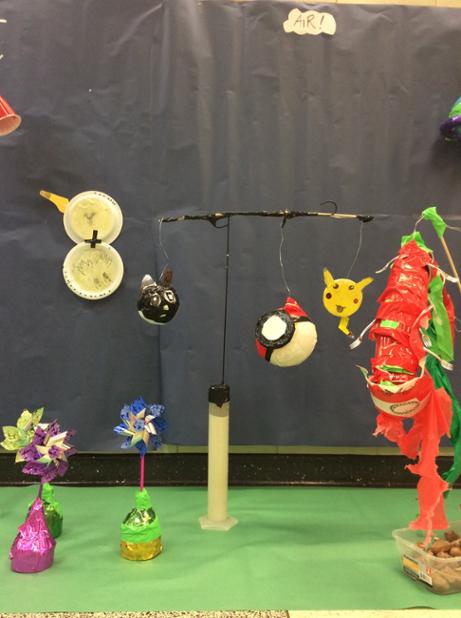
Academic Standards Addressed:
Science and Engineering
2-PS1-2 Matter and Its Interactions
Analyze data obtained from testing different materials to determine which materials have the properties that are best suited for an intended purpose.*
ETS1.A: Defining and Delimiting Engineering Problems
A situation that people want to change or create can be approached as a problem to be solved through engineering. (K-2-ETS1-1)
Asking questions, making observations, and gathering information are helpful in thinking about problems. (K-2-ETS1-1)
Before beginning to design a solution, it is important to clearly understand the problem. (K-2-ETS1-1)
ETS1.B: Developing Possible Solutions
Designs can be conveyed through sketches, drawings, or physical models. These representations are useful in communicating ideas for a problem’s solutions to other people. (K-2-ETS1-2)
ETS1.C: Optimizing the Design Solution
Because there is always more than one possible solution to a problem, it is useful to compare and test designs. (K-2-ETS1-3)
1. Understanding and applying media, techniques, and processes
2. Using knowledge of structures and functions
3. Choosing and evaluating a range of subject matter, symbols, and ideas (students understand how their formal choices are connected to their concept and that their art represents bigger ideas)
5. Reflecting upon and assessing the characteristics and merits of their work and the work of others
6. Making connections between visual arts and other disciplines



